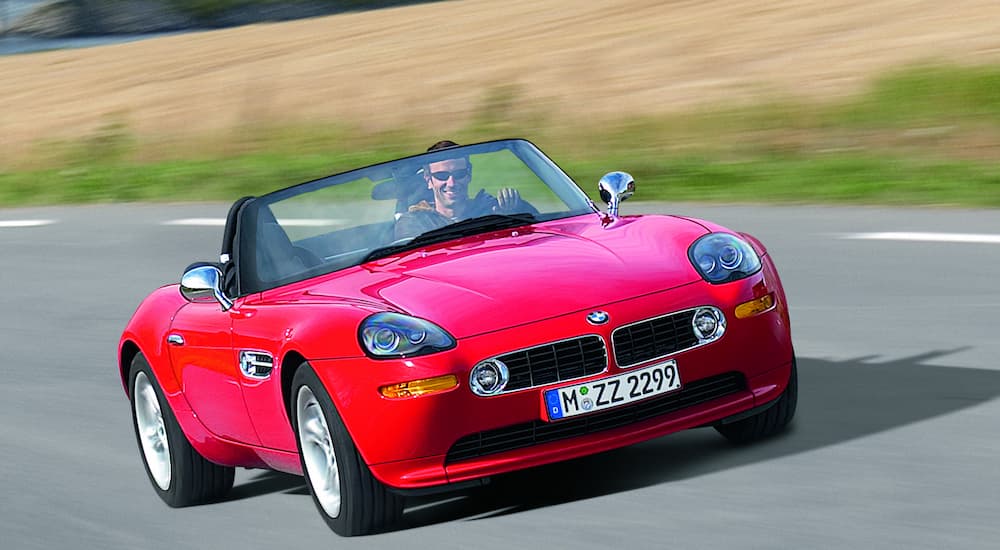BMW has been producing engines since 1916, and the company built its first motorcycle in 1922. The company grew into producing automobiles in 1928, but then the World Wars interrupted production until the 1950s. It would be 1952 when BMW began automobile production again, but it rallied with the manufacture of a high-quality luxury car that set the standard for the company’s future success. Since then, BMW has grown to become one of the world’s largest producers of vehicles for motorsports, motorcycles, and luxury cars. Though you aren’t likely to find the following BMWs at your local BMW dealer, this list includes some of the most noteworthy models of BMW history.
1. BMW CSL 3.0 (1972-75)
With an enormous rear wing, voluminous flared fenders, and a comic book hero’s style, the CSL 3.0 was dubbed the “Batmobile” informally because of its outrageous appearance. Developed by two former Ford Racing Team executives as a homologation model, the CSL was the first of the M series vehicles built for racing. The Batmobile took its first-place finish in 1973 at the European Touring Car Championship thanks to the new design, and then it went on to keep winning in European racing for several years to follow. Now one of the most valuable collector’s items in the BMW ranks since the 1940s, the CSL capably earned its place as one of BMW’s most successful racers.
2. BMW M5 F90 (2018-present)
Since the earliest days of the M series, moving fast was always the desired goal. As a modern vehicle, the F90 holds the record for the quickest zero to 60 time for any M car: 3.1 seconds. The twin-turbo 4.4-liter V8 might have something to do with that, though this racy sedan may just want to live up to its reputation as the “world’s fastest-moving tailored suit,” so named by BMW’s VP of design. Sleek and tidy on the outside, this M5 gives little indication other than its quad exhaust that it can dash at such rapid speeds. Toss in the M xDrive system for speedy Bond-like getaways, and this is one dashing car. Plus, unlike the other models on this list, the F90 is currently available at your BMW dealer–providing you have $103,500 to spare.
3. BMW 328 (1936-40)
The classic 328 racing car took home countless awards when it repeatedly won races through the ’30s and ’40s, handily earning titles for famous events from 24 Hours of Le Mans in 1939 to the Australian Grand Prix in 1948. Incredibly stylish in a devilish sort of way, the 328 oozed both debonair appeal and performance capability. Its aluminum body kept it light and speedy while also sporting the most modern tech of its time. Though it was built before WWII, the classic 328 continued to win awards even after its racing days were done. As recently as 1999, the 328 made the top 25 list for “Car of the Century,” as chosen by a worldwide panel of automotive enthusiasts.
4. BMW 507 Roadster (1956-59)
Few cars achieve the kind of elegance and grace of the 507 with its soft wave-like line from hood to tail and its high-class, understated glamour. The 507 made its first public appearance at the Waldorf-Astoria Hotel in New York City in 1955, the brainchild of US importer Max Hoffman who sweet-talked BMW into producing a new variant of the 501. Unfortunately, the asking price of $10,500 (nearly $100,000 in today’s money) was too steep for even the wealthiest buyers of the day, so despite its desirable allure, BMW only produced 252 examples. It’s said that every unit was hand-built, and each 507 is uniquely its own car because it never saw a traditional production line assembly. As one of the finest cars BMW ever created, individual models are now worth millions.
5. BMW 3200 CS (1962-65)
Another rare commodity, the 3200 CS touring car was also an example of a model inspired by the 501 and was the last of its kind before BMW changed its postwar luxury platform over to the New Class. Sometimes called the “Italian BMW,” the design was created by the Italian design house Gruppo Bertone. Featuring the now-iconic BMW Hofmeister kink, the 3200 is the first to boast the illustrious design element on its C pillar. About 600 examples were produced, but only 50 are said to survive.
6. BMW Z4 M Coupe (2006-08)
Nothing says speed like a long hood and a short tail, and the gorgeous shape of the Z4 M Coupe speaks volumes with its exceptional profile. Another rare find and member of the Hofmeister kink club, the Z4 M Coupe strutted out at the IAA car show in Frankfurt, Germany, in 2005. Fewer than 5,000 units were produced, and it created a stir with its capability. The Z4 M Coupe can race from zero to 60 in about five seconds, and it’s only ever been built with a manual transmission–rightly so. Though its limited-slip differential and S54 inline-six engine are part of the Z4 M’s magnetism, it’s hard to get past its stunning good looks.
7. BMW M3 E30 (1986-91)
BMW wanted to develop a vehicle that could straddle the worlds of street-legal cars and racing champions, and the result was the M3 E30, the very first of the M3 class. Its boxy design might seem odd for a sedan built for racing, but the aerodynamics were chiseled into the frame with its aggressive front splitter, flared rocker panels, and angular rear wing. In order to qualify as a homologated vehicle for racing, BMW had to sell at least 5,000 models in a street-legal design before the car could be entered into a race. Needless to say, the models easily sold out, and the E30 went on to heady success in racing and as a touring car.
8. BMW 1600 GT (1967-68)
When BMW acquired the auto manufacturer Glas GmbH in the late 1960s, the Glas 1700 GT was reconfigured to incorporate a BMW 1.6L engine and the striking BMW double kidney grille. With an already luscious body shape that featured a hood scoop and distinct ridge down the hood’s centerline, the 1700 GT was renamed and rebadged as the BMW 1600 GT. A new suspension improved ride quality and handling, and BMW also changed the tail light design to a circular shape. The result is what is now considered the Glas BMW, which was only in production for one year from 1967-68. Once again, BMW outdoes itself with a stunning creation and then leaves us wanting more. Fewer than 1500 of these legendary GTs were produced.
9. BMW Z8 (2000-03)
The development of the Z8 roadster stemmed from the original 507, whose fate we know was the result of its expensive price tag rather than its appeal. Being such a glamorous and attractive vehicle, BMW designers Henrik Fisker and Scott Lempert wanted to revive the former roadster in the hopes that it would become a collector’s item. Like the original 507, the Z8 was built with aluminum and built by hand rather than on an assembly line. However, it was powered by a much larger 4.9L V8 engine, which was placed behind the front axle for better weight distribution. Because BMW wanted to put minds at ease about the limited production (with the intention of it becoming a valuable collector’s item), the company promised to keep a back stock of parts to last the next 50 years so owners could buy with confidence.
10. BMW M1 (1978-81)
Possibly the most unique BMW of all time arose out of a collaboration with Lamborghini to create the M1, a BMW that defies the typical trademark styling of the brand as a clean-lined vehicle. Instead, designer Giorgetto Giugiaro drew up the M1 as a flat, low mid-engine sports car that bore a closer resemblance to a Lambo than a BMW. Nevertheless, the first M class BMW was born for racing, and much like the E30 to follow a few years later was intended to be homologated as a street-legal car first. Only 400 models were produced, which meant it never achieved its intended status, but it was one of the fastest street-legal cars on the market in its day.






